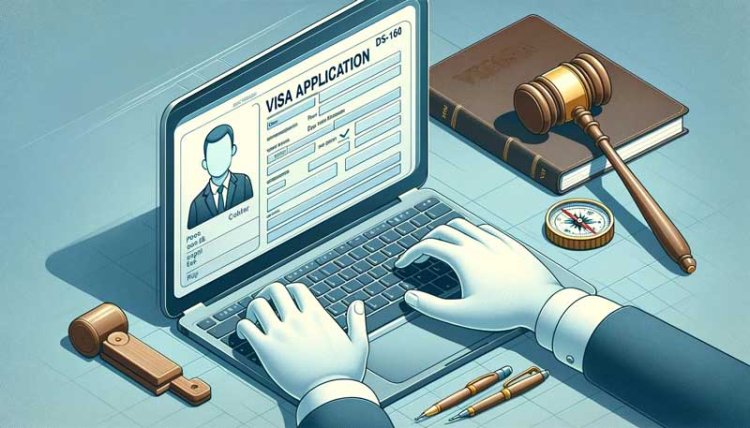Mastering the DS-160 Form for B1/B2 Visa Applicants from India: A Comprehensive Guide
Learn how to complete the DS-160 Form for B1/B2 visa applications from India. This comprehensive guide covers the step-by-step process, required documentation, and submission tips for a successful application.

Mastering the DS-160 Form for B1/B2 Visa Applicants from India: A Comprehensive Guide
The United States has always been a sought-after destination for people worldwide, whether for tourism, work, education, or family visits. However, for most international travelers, obtaining a visa is a mandatory requirement, and one crucial aspect of this process is the DS-160 Visa Application Form. In this blog post, we will delve into the nuances of obtaining your DS-160 visa, providing a thorough guide to help you successfully navigate this crucial stage of your journey to the United States.
What is the DS-160 Form?
The DS-160 Form, also known as the Online Nonimmigrant Visa Application, is a digital application required for obtaining a U.S. visa for a temporary visit. This form is completed online on the U.S. Department of State's website. It collects information about you, such as your name, passport details, travel history, and the purpose of your visit. Additionally, a passport-sized photo of yourself must be uploaded as part of the application.
Following the submission of the DS-160 Form, most applicants are required to arrange an interview appointment at the U.S. embassy or consulate in their home country. During this interview, a U.S. official reviews your application, poses questions, and determines your eligibility for the visa.
The DS-160 Form is paramount as it assists the U.S. government in gathering information, assessing security concerns, and ascertaining your eligibility for a temporary visit to the U.S. If your plans involve quick travel to the U.S., completing and submitting this form is typically a mandatory step.
Types of U.S. Visas:
U.S. nonimmigrant visas come in various types to cater to different purposes:
- B-1 and B-2 Visas (Visitor Visas): B-1 visas are for business visitors, enabling them to attend meetings conferences, and engage in contract negotiations, while B-2 visas are for tourists and individuals on leisure, medical, or social visits.
- F-1 Visa (Student Visa): F-1 visas are designed for international students pursuing academic studies in approved U.S. educational institutions.
- H-1B Visa (Temporary Worker Visa): H-1B visas are for foreign professionals with specialized skills or knowledge offered employment by U.S. companies.
- J-1 Visa (Exchange Visitor Visa): J-1 visas cater to individuals participating in approved exchange programs, encompassing students, scholars, and cultural exchange initiatives.
- L-1 Visa (Intracompany Transfer Visa): L-1 visas are for employees of multinational companies being transferred to a U.S. office.
- O-1 Visa (Extraordinary Ability Visa): O-1 visas are for individuals with exceptional talents or accomplishments in science, arts, education, business, or athletics.
- E-1 and E-2 Visas (Treaty Trader and Investor Visas): E-1 visas are for individuals engaged in substantial trade between the U.S. and their home country.
- K-1 Visa (Fiancé/Fiancée Visa): K-1 visas are intended for foreign individuals who are engaged to U.S. citizens and intend to marry in the United States.
- R-1 Visa (Religious Worker Visa): R-1 visas are intended for religious workers like ministers or missionaries employed by religious organizations in the United States.
Purpose of the DS-160 Visa Application Form:
The primary purpose of the DS-160 Form, officially named the Online Nonimmigrant Visa Application, is to collect essential information from individuals applying for U.S. nonimmigrant visas. This digital application form serves several vital functions:
- Standardized Information Gathering: The DS-160 Form standardizes the visa application process by gathering consistent information from all applicants, ensuring fairness and consistency in decision-making.
- Personal Information: It collects personal details about the applicant, including full name, date of birth, nationality, and contact information.
- Passport Information: The form captures passport details, such as the passport number, issuance date, and expiration date. A valid passport is generally a requirement for obtaining a U.S. visa.
- Family Information: The DS-160 Form requests information about the applicant's family, including their spouse, children, and parents.
- Purpose of Travel: It inquires about the reason for the trip to the United States, whether for tourism, business, education, work, or other purposes.
Step-by-Step Process to Fill Out the Form:
1. Accessing the DS-160 Form: Visit the Consular Electronic Application Center website and log in or create an account.
2. Signing In: Begin completing the form, ensuring a stable internet connection and enough time. Choose a security question and provide an answer for future logins.
3. Answering the Questions: The DS-160 form comprises sections for Personal, Family, Work/Education/Training, and Security information. Provide accurate details in each section.
4. Additional Point of Contact: Provide an additional point of contact for emergencies or assistance with your visa application.
5. SEVIS Information (F/M Visas): Displayed for F and M visa applicants.
6. Uploading a Photo: Upload a recent digital photo meeting specified requirements.
7. Application Review: Double-check all information for accuracy to avoid delays or denial.
8. Submitting the Form: Upon successful submission, note where to submit your visa application and print the confirmation page.
Documentation Required:
The DS-160 application form necessitates specific documentation and information for accurate completion, which may vary based on the visa type and location of the U.S. embassy or consulate. Standard documents and information often required when filling out the DS-160 form include:
- Passport: A valid passport must enter passport information, including the passport number, issuance date, and expiration date.
- Travel Itinerary: Details regarding your planned travel, including proposed arrival and departure dates from the United States, which may include flight reservations.
- Digital Passport-Sized Photo: Generally, applicants are asked to upload a recent digital passport-sized photo meeting specific size, format, and background color requirements.
- Education and Work History: Information about your educational background and employment history, encompassing current and previous employers.
- Family Information: Details about immediate family members, including names, dates of birth, and current locations.
- DS-160 Confirmation Number: If you've initiated a DS-160 application previously and are completing it later, you'll require the confirmation number generated when you began the application.
- Visa Appointment Confirmation: When scheduling your visa interview, you receive the appointment confirmation page or number.
- Financial Documents: Depending on your visa type and circumstances, you might need to provide financial documents like bank statements, pay stubs, or sponsorship information to demonstrate your ability to cover expenses during your U.S. stay.
Submission of the Form:
Timely submission of the DS-160 form is crucial. Start early, ensure passport validity, gather required documentation, save the DS-160 confirmation number, pay visa fees, and note the visa expiration date.
Conclusion: Completing the DS-160 form is a critical step in the journey to obtaining a B1/B2 visa to the United States for individuals from India. By understanding the purpose of the form and following the step-by-step process diligently, applicants can enhance their chances of a successful visa application. This comprehensive guide equips you with the knowledge and confidence to navigate the DS-160 visa application process successfully, making your aspirations of visiting the United States a reality. Have a safe journey!
















